From Earth to the Moon. History and mathematics. Part 1

If we go down in history of studying the flight paths from the Earth to the Moon, then it is necessary to return a century and a half ago, in 1865, when Jules Verne's new novel “From Earth to the Moon Directly in 97 Hours and 20 Minutes” was published. Of course, this was not the first book in which such a flight was described, but it was the first novel in which the author decided to approach the description of a journey from a scientific point of view.
Moreover, the level of preparation of this text is particularly well understood now, since for the first time it was not just the space travel that was shown, but all the nuances, sometimes quite small, were analyzed in detail. Now love to criticize the novel for the mistakes that made by the author. But with this amount of work it would be surprising if there were no mistakes at all! And now it’s not his mistakes that hit him more, but what he turned out to be right about. For example, in their idea, the oxygen purification systems both on the Columbiada projectile and on the Soyuz spacecraft are very similar. Only Jules Verne had sodium hydroxide, and now lithium hydroxide is used.
')
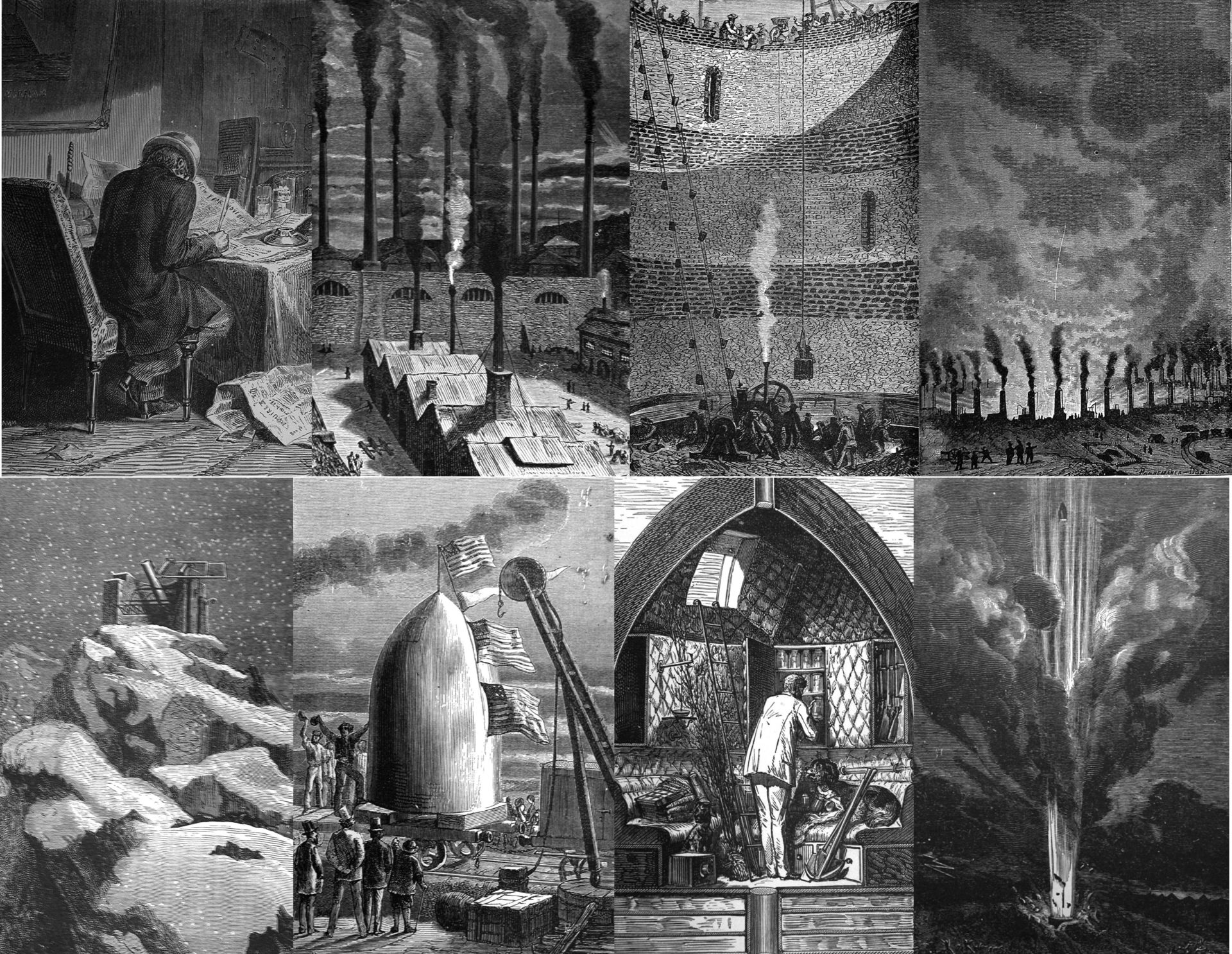
Even more interesting are those moments in which he turned out to be right, despite the wrong premises. For example, Perelman criticized him for giving erroneous data on the time of the flight from Earth to the Moon and even carried them into the name of the novel. The mathematician carried out more accurate calculations for this method, receiving a figure of about six days, two days more than in the novel. And his calculations, in the framework of this method, were indeed correct. Only in four days it’s really possible to fly to the moon (in fact, many vehicles reached the moon in about this time), but in six days it’s already impossible. The calculation method was chosen by the science fiction writer incorrectly, and the figure was correct!
Still, for example, soon after the release of the novel Around the Moon, many doubted the possibility of a similar trajectory of a close flyby of the Moon under the action of only gravitational forces. Only at the beginning of the twentieth century, when estimating orbits in systems of binary stars, did the possibility of the existence of such orbits really be shown. Here is what the English magazine "Knowledge" wrote at the beginning of the twentieth century in the article "Astronomy with Jules Verne":
“The curve described by J. Verne’s projectile gives rise to very interesting questions. It begins and ends on Earth and is a closed orbit of a projectile. Such an orbit should be described by a particle ejected from the Earth and exposed only to the force of the earth. But under the simultaneous action of the Earth and the Moon, the shape of the orbit must obviously change. This was mentioned for the first time, it seems, by Burro, who investigated various special cases related to this. George Darwin also investigated similar cases. But only recently was the general theory of this question given by Professor F. R. Multon, who proved the existence of such orbits and found the necessary initial conditions for their existence. Jules Verne had anticipated all these studies for a long time, and we must, of course, be credited with the convincing development of this question. ”
In other words, the tasks that Jules Verne tried to solve at that time were not just at the forefront of science - they often raised questions that science could not answer at that time.
However, we must not forget that he did not do all this alone. When writing all his books, the author tried to turn to specialists in any field. According to his diaries, his cousin Henri Garceau (1815-1871), a mathematics teacher at the Lyceum of Napoleon (now the lyceum of Henry IV), made calculations for a flight from Earth to the Moon. By the way, here you can see his book in French, devoted to the Cosmography of Leçons nouvelles de Cosmographie (1854). And his calculations were fairly accurate. For example, here, according to the data given in the book, I calculated the exact start date for the Columbiad crew.
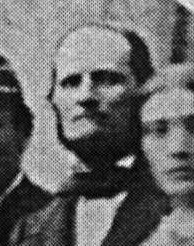
Henri Garcet (1815–1871)
However, we probably would not have learned about his calculations if Jules Verne had not placed them at the very beginning of the book Around the Moon, using them in the conversation of the crew of the Columbiad projectile. They write that the readers of the newspaper “Debate” of November 7, 1869 were literally amazed to see complex mathematical calculations — the publication of the novel began in this newspaper.
Here is how the mathematical model of the flight was described by the mouth of Michel Ardan and Barbichen:
“Do you know, Barbicane, what was I thinking all night?”
- About what? - asked the chairman.
- I was thinking about our Cambridge friends. You, of course, noticed that I don’t know a damn thing about math. So: I just can not understand how our scientists at the observatory could calculate the speed that the projectile must have in order to reach the moon.
“You mean,” interrupted Barbicane, “to that neutral point, where the forces of the earth’s and lunar attraction are the same, because from this point, which is almost nine-tenths of the total distance between both planets, the projectile will fly to the moon by itself, gravity.
“Well, yes, that is what I meant,” said Michel. “But how did they figure out this speed?”
- Nothing is easier.
“Would you be able to do this calculation yourself?”
...
- Yes, dear friend. Taking into account all known conditions of the problem:
the distance from the center of the Earth to the center of the Moon, the radius of the Earth, the mass of the Earth, the mass of the Moon, I can accurately determine the initial velocity of our projectile, and at the same time using the simplest formula.
- What is the formula?
- But you will see. But only I will not cross out the curve described by our projectile between the Moon and the Earth, given their relative motion around the Sun. Suppose both planets are motionless. That will be completely sufficient.
- Why?
“Because it is in this way that the tasks called“ three-body problems ”are solved, but the integral method for solving such problems is not yet sufficiently developed.
After some time, the formula was introduced, which was presented to the readers:

where r is the radius of the Earth, is the distance between the centers of the Earth and the Moon, x is the distance of the nucleus from the Earth. V 0 is the initial velocity of the nucleus. V- speed at a distance x.
A flight looked like this

Here I would like to note that this formula with the specified initial data is indeed correct. And it really accurately reflects the gravitational effect of the Earth and the Moon on the apparatus at any given time. It is quite easy to derive from the law of conservation of energy.
Derivation of the Verna Gare Formula
The sum, taking into account the kinetic and potential energy, looks like
mv 2/2 - γM m / R - γM m / R = const
where m and M 3 , M L - the mass of the projectile, the Earth and the Moon,
γ is the universal gravitational constant, R L is the distance to the center of the Moon, R 3 is the distance to the center of the Earth
We proceed to the notation of the novel. And on the right side we take the data at the time of launch.
mv 2/2 - γM m / x– γM m / (Dx) = mv 0 2/2 - γM m / r - γM m / (dr)
We reduce by m, we transfer
v 2/2 –v 0 2/2 = γM / x + γM / (Dx) - γM / r - γM / (dr)
1/2 * (v 2 -v 0 2 ) = γM (1 / -1 / r + M / M * 1 / (dx) -M / M * 1 / (dr))
1/2 * (v 2 -v 0 2 ) = γM / r (r / -1 + M / M (r / (dx) -r / (dr))
Well, since mg = mγM / r 2 it follows γM = g * r 2
we get the initial formula
1/2 * (v 2 -v 0 2 ) = gr (r / x-1 + M L / M 3 (r / (dx) -r / (dr))
mv 2/2 - γM m / R - γM m / R = const
where m and M 3 , M L - the mass of the projectile, the Earth and the Moon,
γ is the universal gravitational constant, R L is the distance to the center of the Moon, R 3 is the distance to the center of the Earth
We proceed to the notation of the novel. And on the right side we take the data at the time of launch.
mv 2/2 - γM m / x– γM m / (Dx) = mv 0 2/2 - γM m / r - γM m / (dr)
We reduce by m, we transfer
v 2/2 –v 0 2/2 = γM / x + γM / (Dx) - γM / r - γM / (dr)
1/2 * (v 2 -v 0 2 ) = γM (1 / -1 / r + M / M * 1 / (dx) -M / M * 1 / (dr))
1/2 * (v 2 -v 0 2 ) = γM / r (r / -1 + M / M (r / (dx) -r / (dr))
Well, since mg = mγM / r 2 it follows γM = g * r 2
we get the initial formula
1/2 * (v 2 -v 0 2 ) = gr (r / x-1 + M L / M 3 (r / (dx) -r / (dr))
So what's the deal? The problem is that it does not take into account the dynamics of the system. The moon rotates around the Earth at a speed of about 1 km / s. This is exactly the problem of this task. As a result, when trying to fly according to the above scheme, when the station flies to a neutral point between the Earth and the Moon, it will not be captured by the field of the Moon at all, since the latter will fly away from the projectile at a speed of 1 kilometer per second, and the projectile will begin to fall to Earth. But then there was hope that the seizure of the apparatus by the Moon would still happen, and such a scheme would, in the first approximation, accurately show the flight dynamics. Thanks to Jules Verne, this method of calculating flight soon became very popular. It began to be used not only in art books, but also in serious scientific works.
It should be noted that then astronomers just understood the importance of taking into account the dynamics. Yes, and differential equations that take into account both gravity and dynamics, then they could easily compose. But it also failed to find their simple solution. Actually, as is now well understood, the three-body problem does not have a common analytical solution. The task could be solved only numerically, which meant a very, very large number of routine calculations that could spend months or even years of life. At the time of publication of the novel, a similar problem was solved numerically only two times. And the first attempt was more than a hundred years before the publication of the novel, in 1759.
It is known that Edmund Halley, compiling a catalog of comets, noticed that several comets that appeared in the sky at different times have very similar parameters. Having checked them, he decided that it could be the same comet. Then she would be named after him. Comet Halley appeared in the sky in 1531, 1607 and 1682. That is, the period of circulation was 75-76 years, and the scientist predicted the next appearance for 1758. And everything would be great if it were not for one “but”: during the estimated time, the comet in the sky never appeared.
Then the French mathematician Cleo decided to calculate its trajectory as accurately as possible. Including, taking into account the perturbations of its trajectory due to the attraction of Jupiter and Saturn. It was very tedious and long work, although he did not do this work alone: he was helped by astronomer J. Lalande and mathematician Madame Lepot. It turned out that the difference with the previous estimates of the comet's orbital period is 618 days, and it will arrive at its perihelion on April 13, 1759. With a possible error for a month. The estimate turned out to be very accurate: the comet passed its perihelion on March 12. It was a victory for mathematicians, and a very good confirmation of Newton's laws.
Lalande wrote about this calculation: “ For six months we calculated from morning to night, sometimes without even looking up from food, and the result was that I had upset my health for the rest of my life. Mrs. Lepot’s help was such that without it, we would never dare to undertake this tremendous work, consisting of calculating the distance of a comet from two planets - Jupiter and Saturn - for each degree of the celestial sphere for 150 years. "
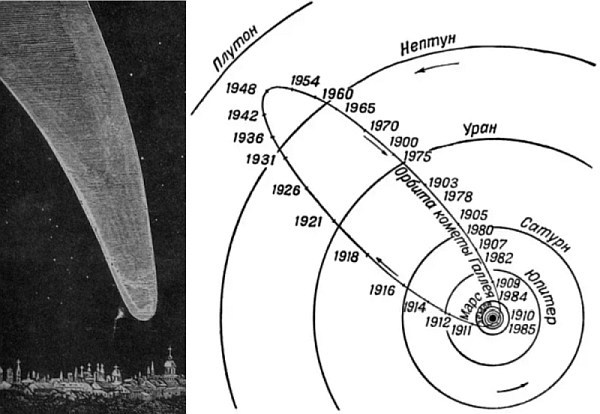
You can see the trajectory of Comet Halley relative to the orbits of the planets.
The second time a similar method was applied in 1829, again when calculating the trajectory of Comet Halley. The estimates gave the comet's return date to the Sun, November 15, 1835. The comet returned on November 16, just a day late.
As a result, a similar numerical method proved its accuracy. But the story above clearly shows how big and tedious work was required. Six months of the work of three mathematicians took to the calculation of just one trajectory with well-known initial parameters! But in order to calculate the trajectories of the flight from the Earth to the Moon, it was necessary to estimate dozens, if not hundreds of trajectories, with different initial parameters. Otherwise, it is impossible to get, say, the exact speed, the start date, the characteristics of the trajectory, possible errors, the flight parameters of the station near the Moon, etc. It could take years of life. That is, this solution was considered very difficult. Especially for a task that does not have a special practical meaning.
At the same time, there was also confidence that it was possible to find an analytical solution to the three-body problem. At least allowing, in the first approximation, to estimate the parameters of the flight.
And the method proposed by Jules Verne seemed to give an answer to this question. After all, mathematically, within the framework of the initial assumptions, it was flawless. Yes, he did not take into account the dynamics, but then many expected that such an assumption was normal, and the real trajectory of the projectile motion from the Earth to the Moon would look something like this.
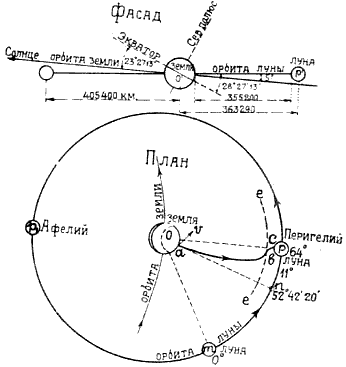
Calculation from the book “Spaceships. (Interplanetary communications in the fantasies of novelists) "1928
And mathematical beauty, coupled with the great popularity of the novel, played a cruel joke: according to this method, almost all the pioneers of space exploration — Goddard , Sternfeld , Obert , Max Valle, and many others — estimated the flight. Sometimes, extremely rarely, they also estimated not direct flight, but on the ellipse of the Earth satellite. But this method also had its drawbacks. For example, and there, for some reason, many were convinced that in order to reach the moon it was enough to fall into its sphere of action; further, they say, the attraction of the moon should do the rest. Although, as mentioned above, the possibility of circling in the three-body problem has already been proven.
A good illustration would be the article by Werner von Braun in the weekly newspaper of October 18, 1952. In it, von Braun described how, in his opinion, the expedition to the moon would look.
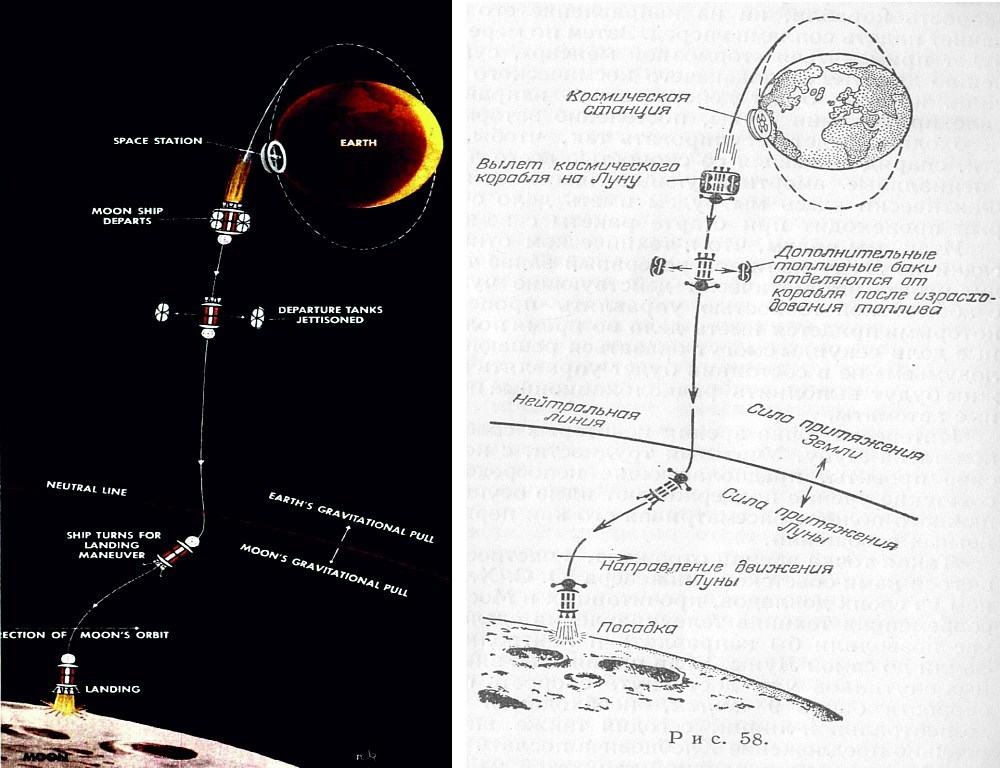
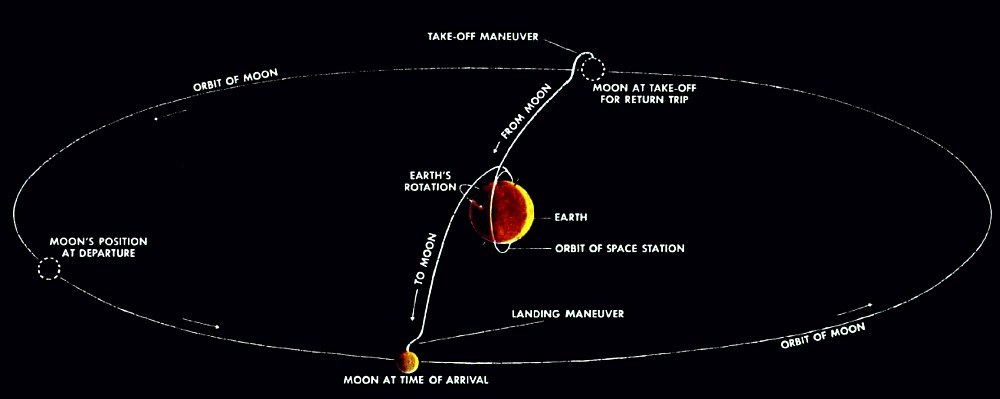
The article itself can be downloaded here.
It is clearly seen from the illustration that it is Jules Verne’s scheme that is represented here: first, reaching a neutral region between the Earth and the Moon, and later - falling to the Moon under the influence of its attraction. The gun has long been replaced by a rocket, but the basic principle has remained unchanged. Although almost a hundred years have passed since the publication of the novel.
But soon the approach to flights from Earth to the Moon began to change. In particular, due to the development of electronic computers.
To be continued.
Source: https://habr.com/ru/post/400013/
All Articles